University Psychology: Assessment Report on Sexual Offender Management
VerifiedAdded on 2023/06/05
|11
|2521
|435
Report
AI Summary
This assessment report examines the case of Mr. Smith, a sexual offender, providing a framework for his treatment by a forensic psychologist. It delves into Mr. Smith's background, including his troubled childhood, criminal history, and current circumstances, to understand the potential causes of his behavior. The report emphasizes the importance of risk assessment, particularly recidivism, and suggests strategies such as cognitive behavioral therapy to address his distorted personality and reduce the likelihood of reoffending. Ethical considerations for the treating psychologist, including maintaining boundaries and addressing potential risks, are also highlighted. The report concludes with recommendations for parole officers and therapists to facilitate Mr. Smith's rehabilitation and reintegration into society.
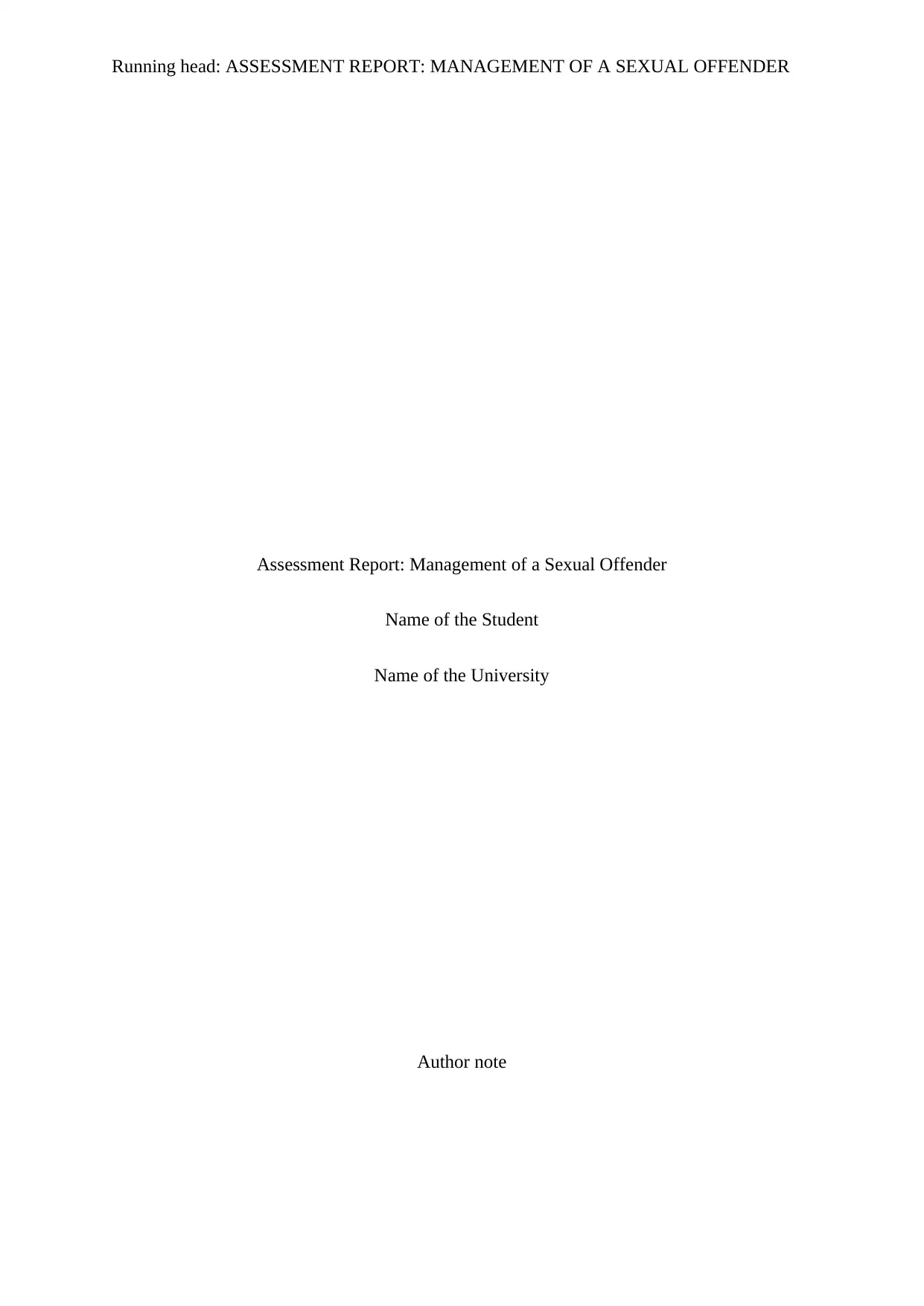
Running head: ASSESSMENT REPORT: MANAGEMENT OF A SEXUAL OFFENDER
Assessment Report: Management of a Sexual Offender
Name of the Student
Name of the University
Author note
Assessment Report: Management of a Sexual Offender
Name of the Student
Name of the University
Author note
Paraphrase This Document
Need a fresh take? Get an instant paraphrase of this document with our AI Paraphraser
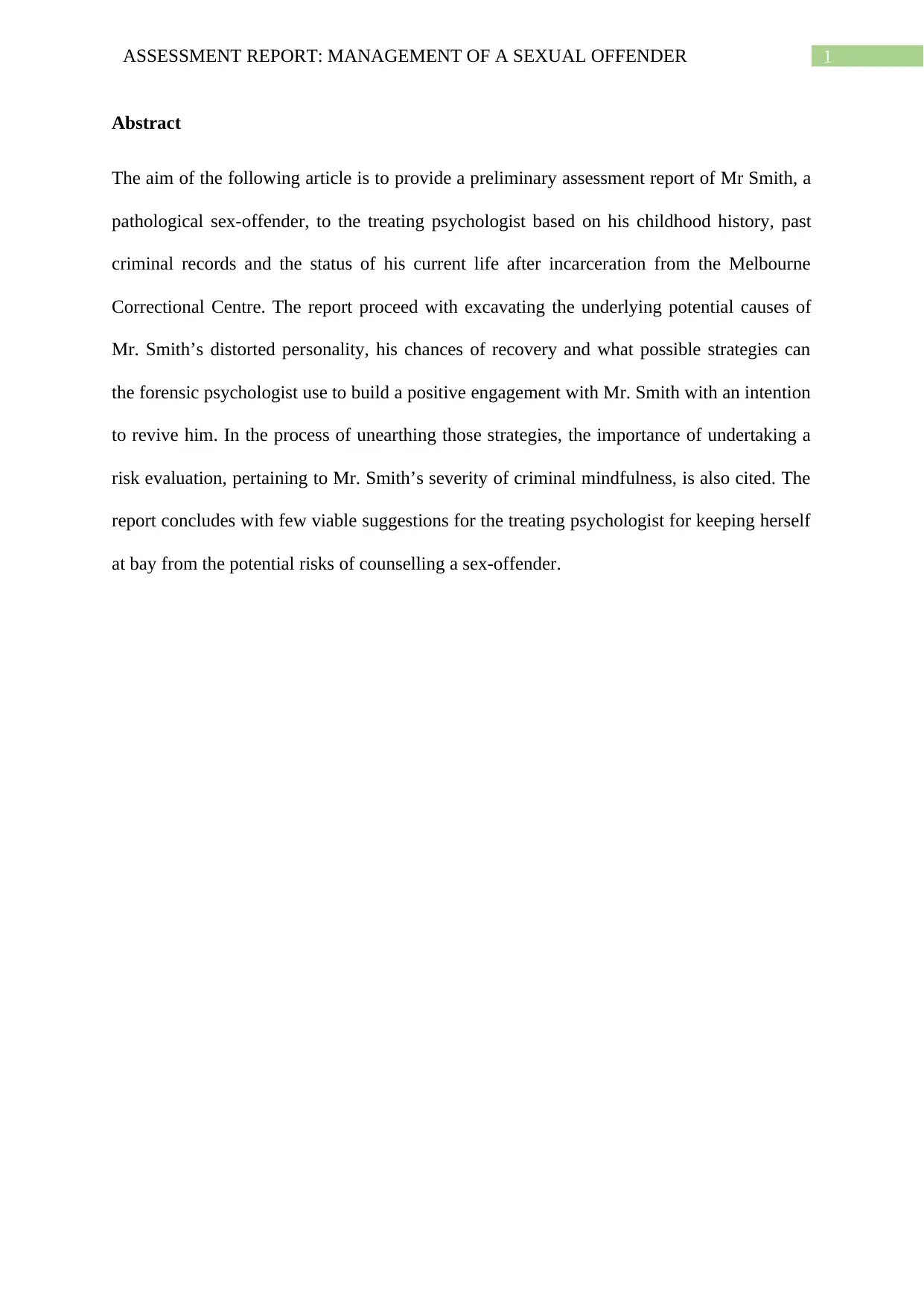
1ASSESSMENT REPORT: MANAGEMENT OF A SEXUAL OFFENDER
Abstract
The aim of the following article is to provide a preliminary assessment report of Mr Smith, a
pathological sex-offender, to the treating psychologist based on his childhood history, past
criminal records and the status of his current life after incarceration from the Melbourne
Correctional Centre. The report proceed with excavating the underlying potential causes of
Mr. Smith’s distorted personality, his chances of recovery and what possible strategies can
the forensic psychologist use to build a positive engagement with Mr. Smith with an intention
to revive him. In the process of unearthing those strategies, the importance of undertaking a
risk evaluation, pertaining to Mr. Smith’s severity of criminal mindfulness, is also cited. The
report concludes with few viable suggestions for the treating psychologist for keeping herself
at bay from the potential risks of counselling a sex-offender.
Abstract
The aim of the following article is to provide a preliminary assessment report of Mr Smith, a
pathological sex-offender, to the treating psychologist based on his childhood history, past
criminal records and the status of his current life after incarceration from the Melbourne
Correctional Centre. The report proceed with excavating the underlying potential causes of
Mr. Smith’s distorted personality, his chances of recovery and what possible strategies can
the forensic psychologist use to build a positive engagement with Mr. Smith with an intention
to revive him. In the process of unearthing those strategies, the importance of undertaking a
risk evaluation, pertaining to Mr. Smith’s severity of criminal mindfulness, is also cited. The
report concludes with few viable suggestions for the treating psychologist for keeping herself
at bay from the potential risks of counselling a sex-offender.
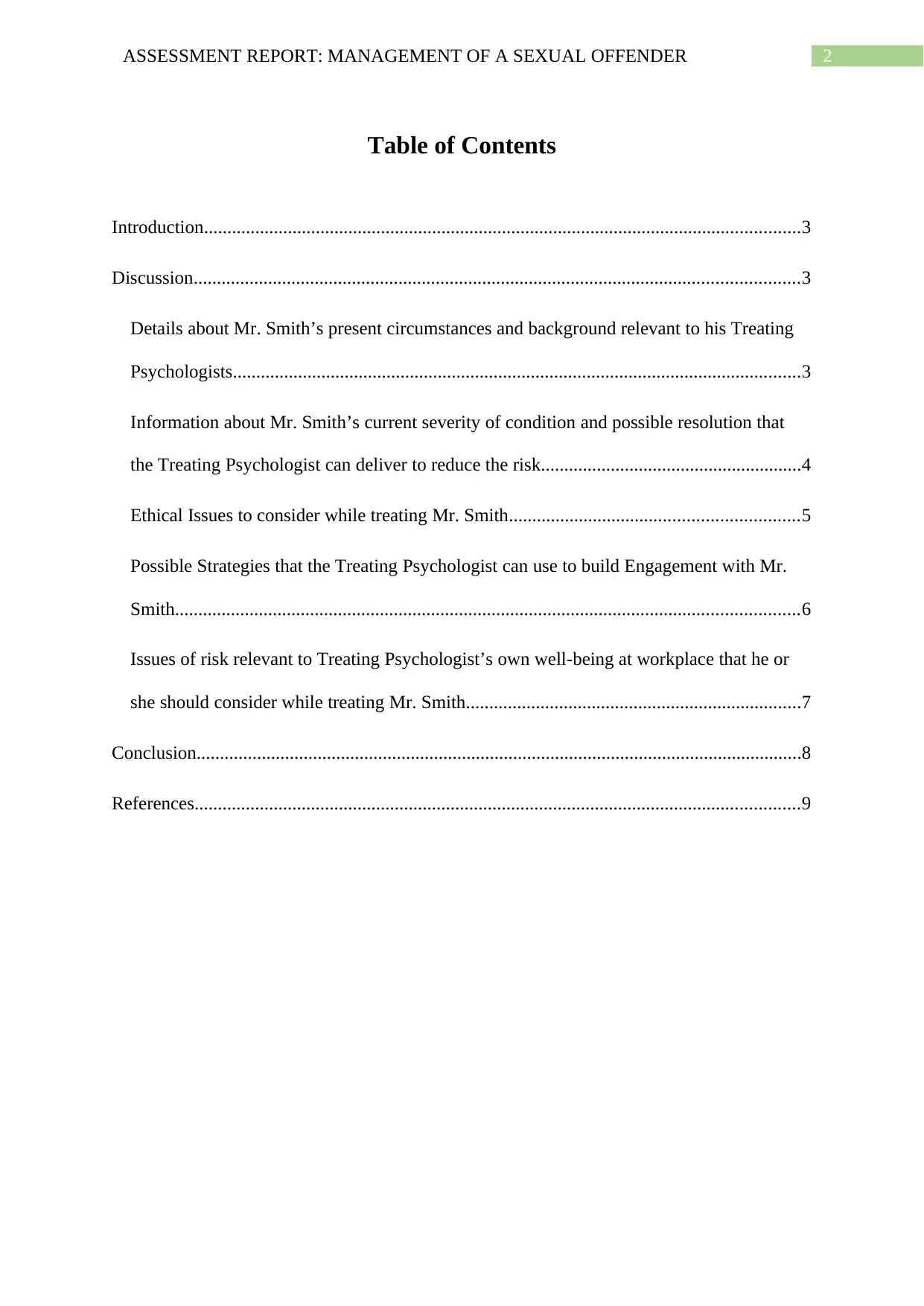
2ASSESSMENT REPORT: MANAGEMENT OF A SEXUAL OFFENDER
Table of Contents
Introduction................................................................................................................................3
Discussion..................................................................................................................................3
Details about Mr. Smith’s present circumstances and background relevant to his Treating
Psychologists..........................................................................................................................3
Information about Mr. Smith’s current severity of condition and possible resolution that
the Treating Psychologist can deliver to reduce the risk........................................................4
Ethical Issues to consider while treating Mr. Smith..............................................................5
Possible Strategies that the Treating Psychologist can use to build Engagement with Mr.
Smith......................................................................................................................................6
Issues of risk relevant to Treating Psychologist’s own well-being at workplace that he or
she should consider while treating Mr. Smith........................................................................7
Conclusion..................................................................................................................................8
References..................................................................................................................................9
Table of Contents
Introduction................................................................................................................................3
Discussion..................................................................................................................................3
Details about Mr. Smith’s present circumstances and background relevant to his Treating
Psychologists..........................................................................................................................3
Information about Mr. Smith’s current severity of condition and possible resolution that
the Treating Psychologist can deliver to reduce the risk........................................................4
Ethical Issues to consider while treating Mr. Smith..............................................................5
Possible Strategies that the Treating Psychologist can use to build Engagement with Mr.
Smith......................................................................................................................................6
Issues of risk relevant to Treating Psychologist’s own well-being at workplace that he or
she should consider while treating Mr. Smith........................................................................7
Conclusion..................................................................................................................................8
References..................................................................................................................................9
⊘ This is a preview!⊘
Do you want full access?
Subscribe today to unlock all pages.

Trusted by 1+ million students worldwide
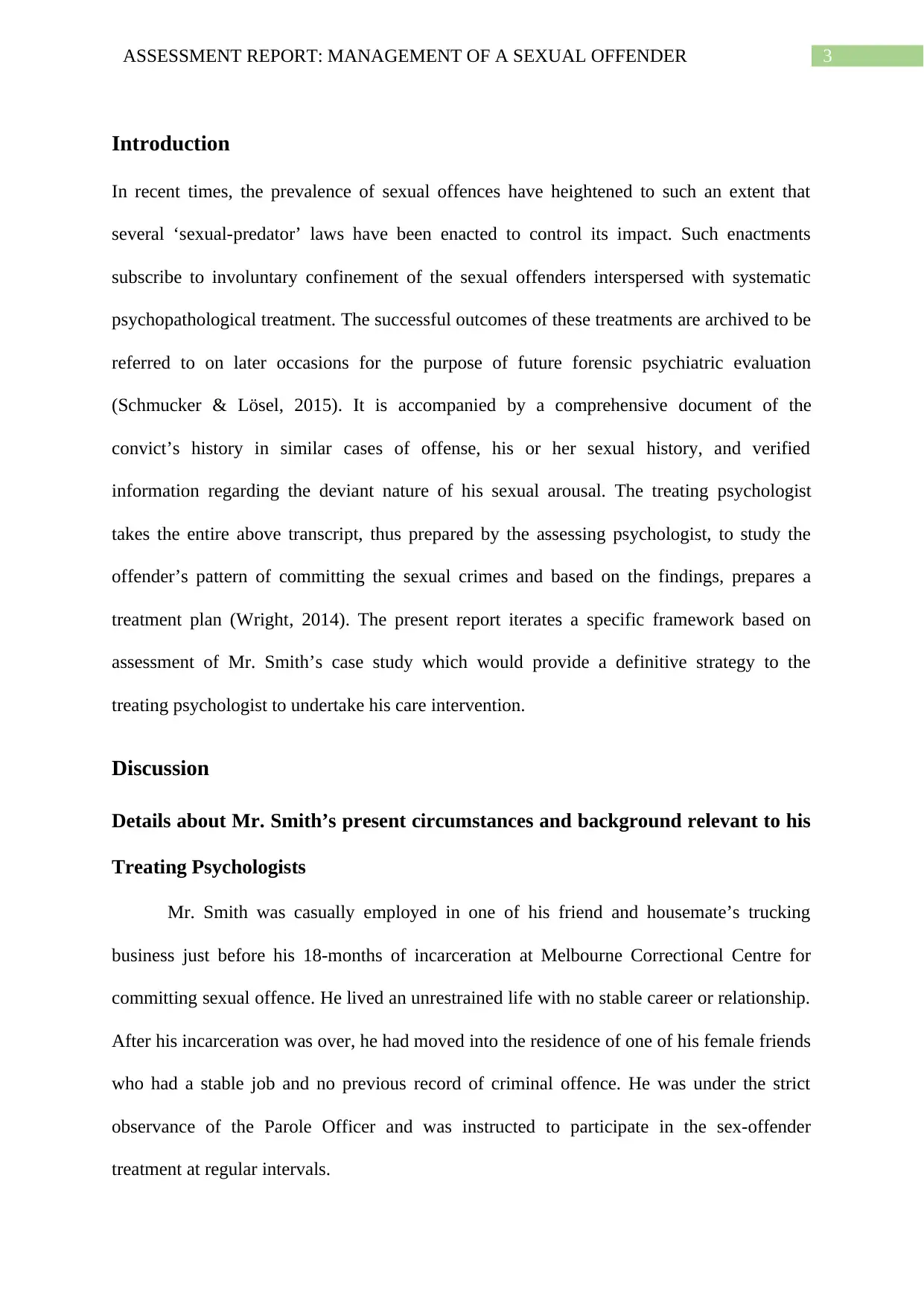
3ASSESSMENT REPORT: MANAGEMENT OF A SEXUAL OFFENDER
Introduction
In recent times, the prevalence of sexual offences have heightened to such an extent that
several ‘sexual-predator’ laws have been enacted to control its impact. Such enactments
subscribe to involuntary confinement of the sexual offenders interspersed with systematic
psychopathological treatment. The successful outcomes of these treatments are archived to be
referred to on later occasions for the purpose of future forensic psychiatric evaluation
(Schmucker & Lösel, 2015). It is accompanied by a comprehensive document of the
convict’s history in similar cases of offense, his or her sexual history, and verified
information regarding the deviant nature of his sexual arousal. The treating psychologist
takes the entire above transcript, thus prepared by the assessing psychologist, to study the
offender’s pattern of committing the sexual crimes and based on the findings, prepares a
treatment plan (Wright, 2014). The present report iterates a specific framework based on
assessment of Mr. Smith’s case study which would provide a definitive strategy to the
treating psychologist to undertake his care intervention.
Discussion
Details about Mr. Smith’s present circumstances and background relevant to his
Treating Psychologists
Mr. Smith was casually employed in one of his friend and housemate’s trucking
business just before his 18-months of incarceration at Melbourne Correctional Centre for
committing sexual offence. He lived an unrestrained life with no stable career or relationship.
After his incarceration was over, he had moved into the residence of one of his female friends
who had a stable job and no previous record of criminal offence. He was under the strict
observance of the Parole Officer and was instructed to participate in the sex-offender
treatment at regular intervals.
Introduction
In recent times, the prevalence of sexual offences have heightened to such an extent that
several ‘sexual-predator’ laws have been enacted to control its impact. Such enactments
subscribe to involuntary confinement of the sexual offenders interspersed with systematic
psychopathological treatment. The successful outcomes of these treatments are archived to be
referred to on later occasions for the purpose of future forensic psychiatric evaluation
(Schmucker & Lösel, 2015). It is accompanied by a comprehensive document of the
convict’s history in similar cases of offense, his or her sexual history, and verified
information regarding the deviant nature of his sexual arousal. The treating psychologist
takes the entire above transcript, thus prepared by the assessing psychologist, to study the
offender’s pattern of committing the sexual crimes and based on the findings, prepares a
treatment plan (Wright, 2014). The present report iterates a specific framework based on
assessment of Mr. Smith’s case study which would provide a definitive strategy to the
treating psychologist to undertake his care intervention.
Discussion
Details about Mr. Smith’s present circumstances and background relevant to his
Treating Psychologists
Mr. Smith was casually employed in one of his friend and housemate’s trucking
business just before his 18-months of incarceration at Melbourne Correctional Centre for
committing sexual offence. He lived an unrestrained life with no stable career or relationship.
After his incarceration was over, he had moved into the residence of one of his female friends
who had a stable job and no previous record of criminal offence. He was under the strict
observance of the Parole Officer and was instructed to participate in the sex-offender
treatment at regular intervals.
Paraphrase This Document
Need a fresh take? Get an instant paraphrase of this document with our AI Paraphraser
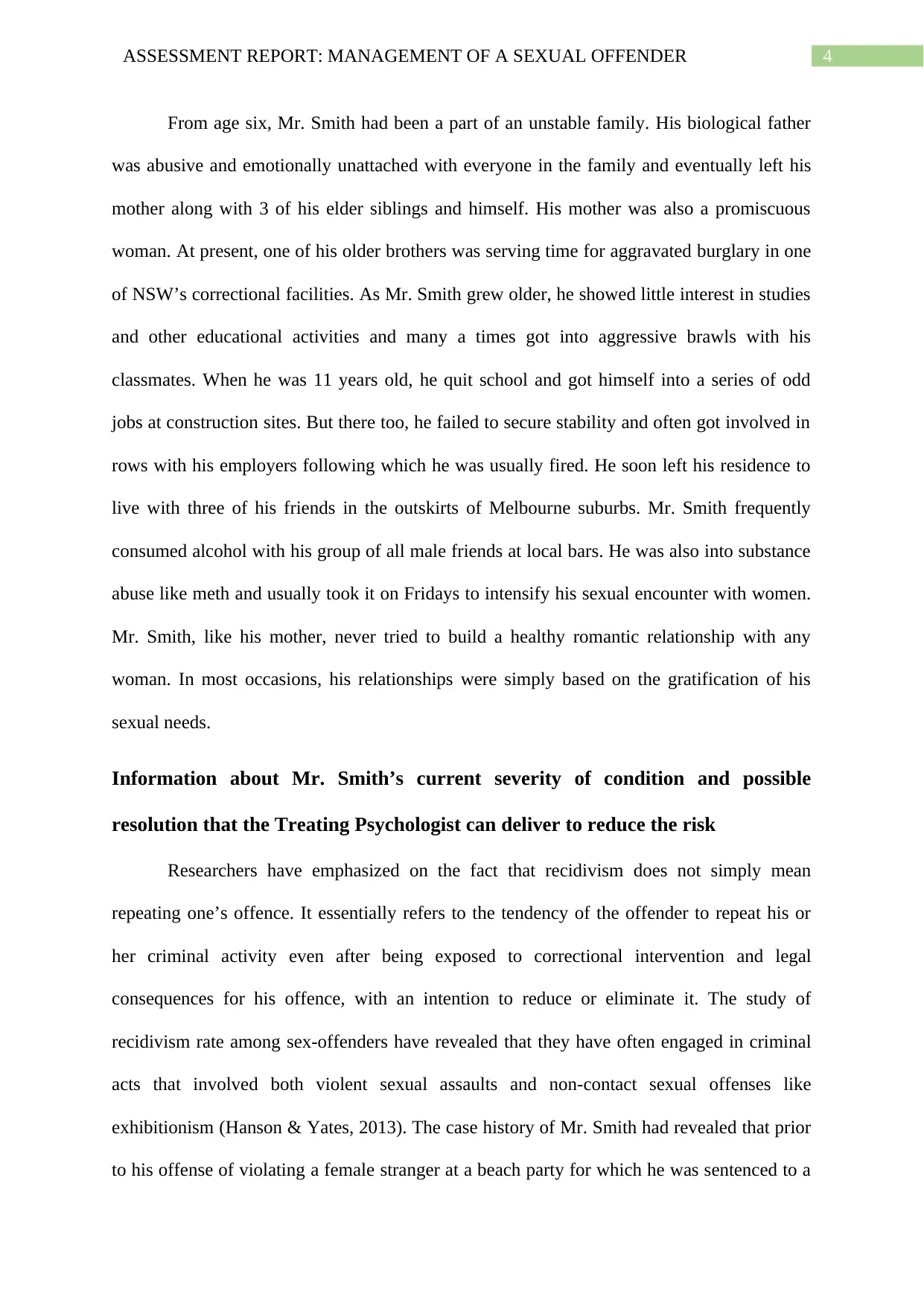
4ASSESSMENT REPORT: MANAGEMENT OF A SEXUAL OFFENDER
From age six, Mr. Smith had been a part of an unstable family. His biological father
was abusive and emotionally unattached with everyone in the family and eventually left his
mother along with 3 of his elder siblings and himself. His mother was also a promiscuous
woman. At present, one of his older brothers was serving time for aggravated burglary in one
of NSW’s correctional facilities. As Mr. Smith grew older, he showed little interest in studies
and other educational activities and many a times got into aggressive brawls with his
classmates. When he was 11 years old, he quit school and got himself into a series of odd
jobs at construction sites. But there too, he failed to secure stability and often got involved in
rows with his employers following which he was usually fired. He soon left his residence to
live with three of his friends in the outskirts of Melbourne suburbs. Mr. Smith frequently
consumed alcohol with his group of all male friends at local bars. He was also into substance
abuse like meth and usually took it on Fridays to intensify his sexual encounter with women.
Mr. Smith, like his mother, never tried to build a healthy romantic relationship with any
woman. In most occasions, his relationships were simply based on the gratification of his
sexual needs.
Information about Mr. Smith’s current severity of condition and possible
resolution that the Treating Psychologist can deliver to reduce the risk
Researchers have emphasized on the fact that recidivism does not simply mean
repeating one’s offence. It essentially refers to the tendency of the offender to repeat his or
her criminal activity even after being exposed to correctional intervention and legal
consequences for his offence, with an intention to reduce or eliminate it. The study of
recidivism rate among sex-offenders have revealed that they have often engaged in criminal
acts that involved both violent sexual assaults and non-contact sexual offenses like
exhibitionism (Hanson & Yates, 2013). The case history of Mr. Smith had revealed that prior
to his offense of violating a female stranger at a beach party for which he was sentenced to a
From age six, Mr. Smith had been a part of an unstable family. His biological father
was abusive and emotionally unattached with everyone in the family and eventually left his
mother along with 3 of his elder siblings and himself. His mother was also a promiscuous
woman. At present, one of his older brothers was serving time for aggravated burglary in one
of NSW’s correctional facilities. As Mr. Smith grew older, he showed little interest in studies
and other educational activities and many a times got into aggressive brawls with his
classmates. When he was 11 years old, he quit school and got himself into a series of odd
jobs at construction sites. But there too, he failed to secure stability and often got involved in
rows with his employers following which he was usually fired. He soon left his residence to
live with three of his friends in the outskirts of Melbourne suburbs. Mr. Smith frequently
consumed alcohol with his group of all male friends at local bars. He was also into substance
abuse like meth and usually took it on Fridays to intensify his sexual encounter with women.
Mr. Smith, like his mother, never tried to build a healthy romantic relationship with any
woman. In most occasions, his relationships were simply based on the gratification of his
sexual needs.
Information about Mr. Smith’s current severity of condition and possible
resolution that the Treating Psychologist can deliver to reduce the risk
Researchers have emphasized on the fact that recidivism does not simply mean
repeating one’s offence. It essentially refers to the tendency of the offender to repeat his or
her criminal activity even after being exposed to correctional intervention and legal
consequences for his offence, with an intention to reduce or eliminate it. The study of
recidivism rate among sex-offenders have revealed that they have often engaged in criminal
acts that involved both violent sexual assaults and non-contact sexual offenses like
exhibitionism (Hanson & Yates, 2013). The case history of Mr. Smith had revealed that prior
to his offense of violating a female stranger at a beach party for which he was sentenced to a
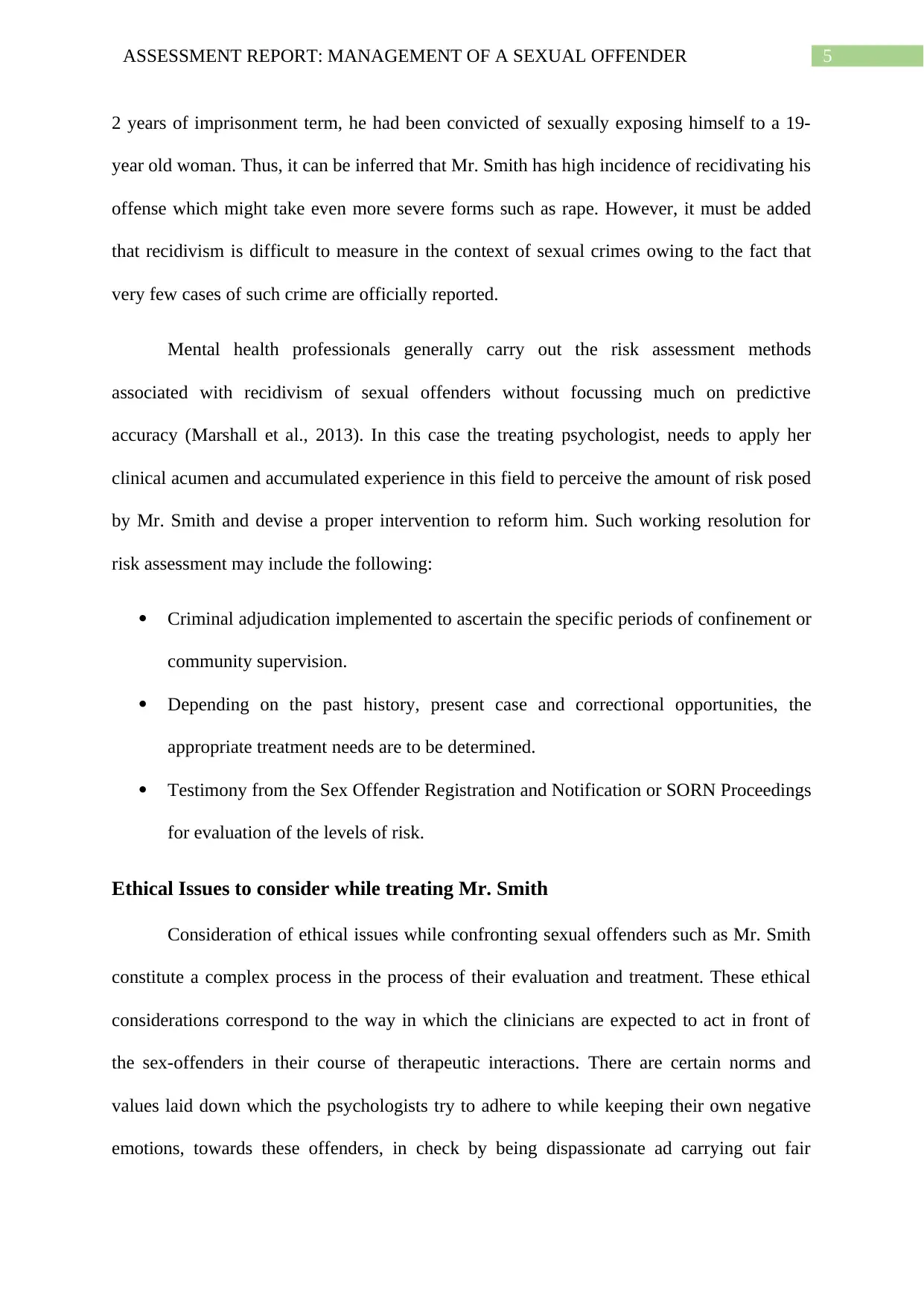
5ASSESSMENT REPORT: MANAGEMENT OF A SEXUAL OFFENDER
2 years of imprisonment term, he had been convicted of sexually exposing himself to a 19-
year old woman. Thus, it can be inferred that Mr. Smith has high incidence of recidivating his
offense which might take even more severe forms such as rape. However, it must be added
that recidivism is difficult to measure in the context of sexual crimes owing to the fact that
very few cases of such crime are officially reported.
Mental health professionals generally carry out the risk assessment methods
associated with recidivism of sexual offenders without focussing much on predictive
accuracy (Marshall et al., 2013). In this case the treating psychologist, needs to apply her
clinical acumen and accumulated experience in this field to perceive the amount of risk posed
by Mr. Smith and devise a proper intervention to reform him. Such working resolution for
risk assessment may include the following:
Criminal adjudication implemented to ascertain the specific periods of confinement or
community supervision.
Depending on the past history, present case and correctional opportunities, the
appropriate treatment needs are to be determined.
Testimony from the Sex Offender Registration and Notification or SORN Proceedings
for evaluation of the levels of risk.
Ethical Issues to consider while treating Mr. Smith
Consideration of ethical issues while confronting sexual offenders such as Mr. Smith
constitute a complex process in the process of their evaluation and treatment. These ethical
considerations correspond to the way in which the clinicians are expected to act in front of
the sex-offenders in their course of therapeutic interactions. There are certain norms and
values laid down which the psychologists try to adhere to while keeping their own negative
emotions, towards these offenders, in check by being dispassionate ad carrying out fair
2 years of imprisonment term, he had been convicted of sexually exposing himself to a 19-
year old woman. Thus, it can be inferred that Mr. Smith has high incidence of recidivating his
offense which might take even more severe forms such as rape. However, it must be added
that recidivism is difficult to measure in the context of sexual crimes owing to the fact that
very few cases of such crime are officially reported.
Mental health professionals generally carry out the risk assessment methods
associated with recidivism of sexual offenders without focussing much on predictive
accuracy (Marshall et al., 2013). In this case the treating psychologist, needs to apply her
clinical acumen and accumulated experience in this field to perceive the amount of risk posed
by Mr. Smith and devise a proper intervention to reform him. Such working resolution for
risk assessment may include the following:
Criminal adjudication implemented to ascertain the specific periods of confinement or
community supervision.
Depending on the past history, present case and correctional opportunities, the
appropriate treatment needs are to be determined.
Testimony from the Sex Offender Registration and Notification or SORN Proceedings
for evaluation of the levels of risk.
Ethical Issues to consider while treating Mr. Smith
Consideration of ethical issues while confronting sexual offenders such as Mr. Smith
constitute a complex process in the process of their evaluation and treatment. These ethical
considerations correspond to the way in which the clinicians are expected to act in front of
the sex-offenders in their course of therapeutic interactions. There are certain norms and
values laid down which the psychologists try to adhere to while keeping their own negative
emotions, towards these offenders, in check by being dispassionate ad carrying out fair
⊘ This is a preview!⊘
Do you want full access?
Subscribe today to unlock all pages.

Trusted by 1+ million students worldwide
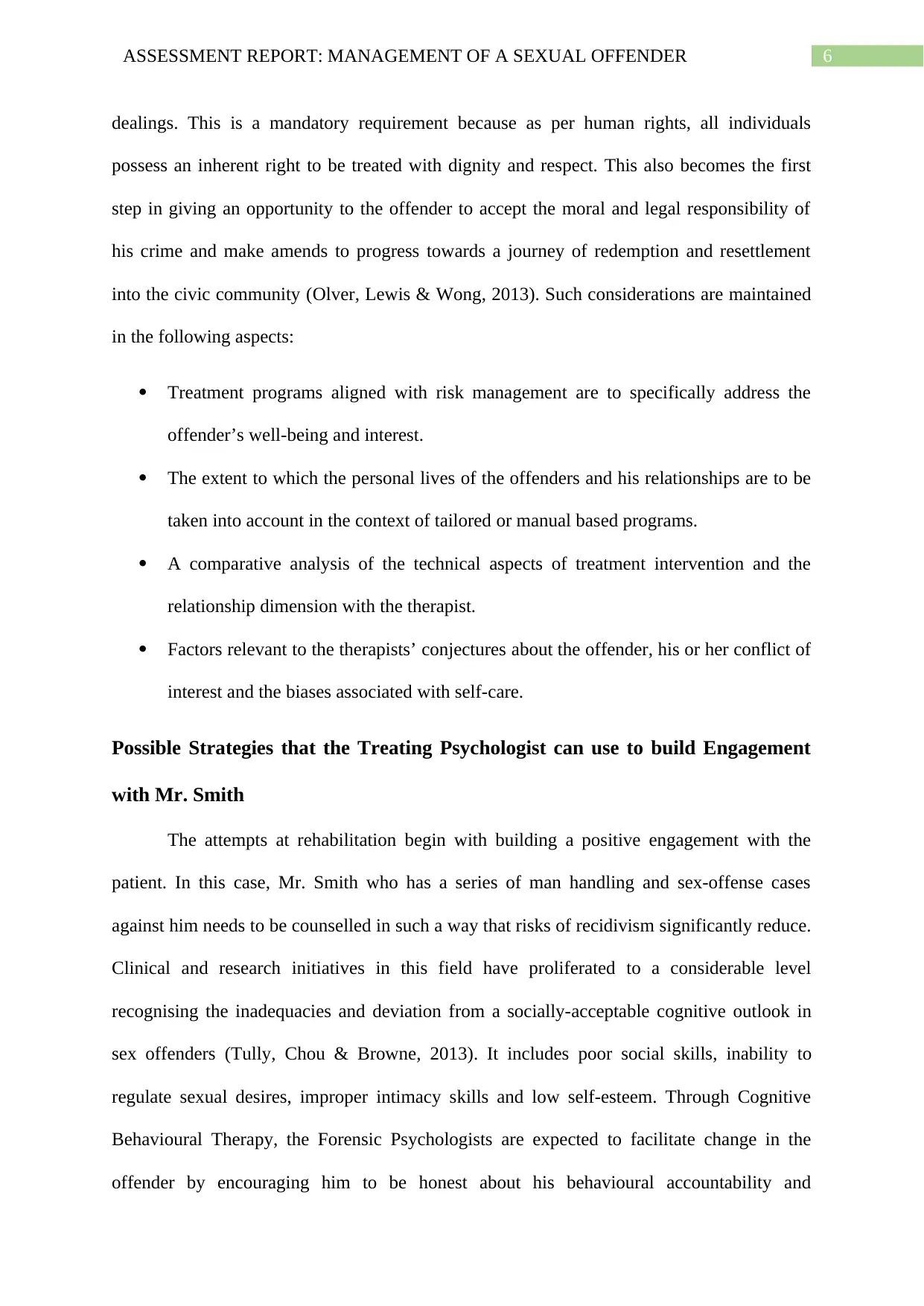
6ASSESSMENT REPORT: MANAGEMENT OF A SEXUAL OFFENDER
dealings. This is a mandatory requirement because as per human rights, all individuals
possess an inherent right to be treated with dignity and respect. This also becomes the first
step in giving an opportunity to the offender to accept the moral and legal responsibility of
his crime and make amends to progress towards a journey of redemption and resettlement
into the civic community (Olver, Lewis & Wong, 2013). Such considerations are maintained
in the following aspects:
Treatment programs aligned with risk management are to specifically address the
offender’s well-being and interest.
The extent to which the personal lives of the offenders and his relationships are to be
taken into account in the context of tailored or manual based programs.
A comparative analysis of the technical aspects of treatment intervention and the
relationship dimension with the therapist.
Factors relevant to the therapists’ conjectures about the offender, his or her conflict of
interest and the biases associated with self-care.
Possible Strategies that the Treating Psychologist can use to build Engagement
with Mr. Smith
The attempts at rehabilitation begin with building a positive engagement with the
patient. In this case, Mr. Smith who has a series of man handling and sex-offense cases
against him needs to be counselled in such a way that risks of recidivism significantly reduce.
Clinical and research initiatives in this field have proliferated to a considerable level
recognising the inadequacies and deviation from a socially-acceptable cognitive outlook in
sex offenders (Tully, Chou & Browne, 2013). It includes poor social skills, inability to
regulate sexual desires, improper intimacy skills and low self-esteem. Through Cognitive
Behavioural Therapy, the Forensic Psychologists are expected to facilitate change in the
offender by encouraging him to be honest about his behavioural accountability and
dealings. This is a mandatory requirement because as per human rights, all individuals
possess an inherent right to be treated with dignity and respect. This also becomes the first
step in giving an opportunity to the offender to accept the moral and legal responsibility of
his crime and make amends to progress towards a journey of redemption and resettlement
into the civic community (Olver, Lewis & Wong, 2013). Such considerations are maintained
in the following aspects:
Treatment programs aligned with risk management are to specifically address the
offender’s well-being and interest.
The extent to which the personal lives of the offenders and his relationships are to be
taken into account in the context of tailored or manual based programs.
A comparative analysis of the technical aspects of treatment intervention and the
relationship dimension with the therapist.
Factors relevant to the therapists’ conjectures about the offender, his or her conflict of
interest and the biases associated with self-care.
Possible Strategies that the Treating Psychologist can use to build Engagement
with Mr. Smith
The attempts at rehabilitation begin with building a positive engagement with the
patient. In this case, Mr. Smith who has a series of man handling and sex-offense cases
against him needs to be counselled in such a way that risks of recidivism significantly reduce.
Clinical and research initiatives in this field have proliferated to a considerable level
recognising the inadequacies and deviation from a socially-acceptable cognitive outlook in
sex offenders (Tully, Chou & Browne, 2013). It includes poor social skills, inability to
regulate sexual desires, improper intimacy skills and low self-esteem. Through Cognitive
Behavioural Therapy, the Forensic Psychologists are expected to facilitate change in the
offender by encouraging him to be honest about his behavioural accountability and
Paraphrase This Document
Need a fresh take? Get an instant paraphrase of this document with our AI Paraphraser
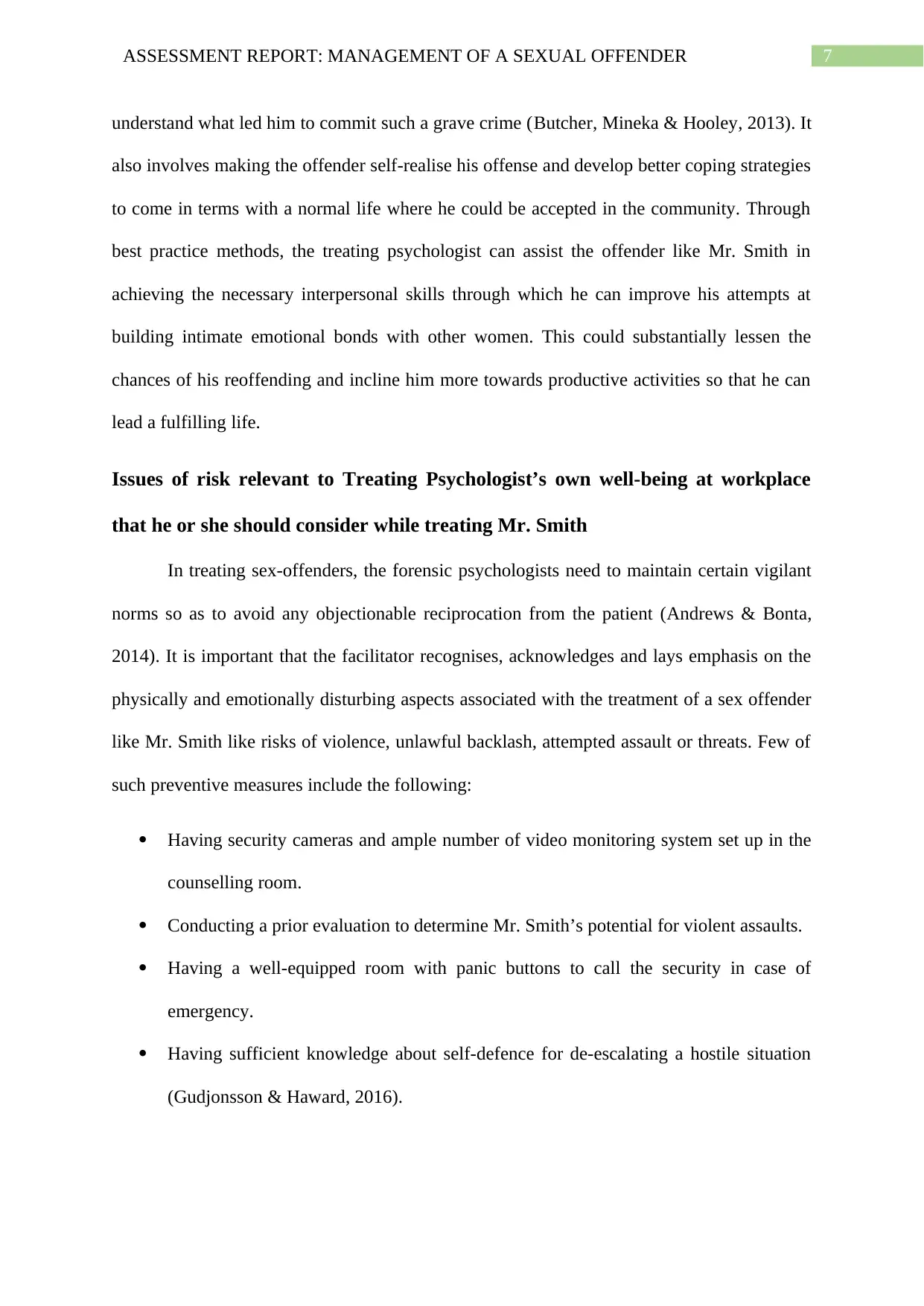
7ASSESSMENT REPORT: MANAGEMENT OF A SEXUAL OFFENDER
understand what led him to commit such a grave crime (Butcher, Mineka & Hooley, 2013). It
also involves making the offender self-realise his offense and develop better coping strategies
to come in terms with a normal life where he could be accepted in the community. Through
best practice methods, the treating psychologist can assist the offender like Mr. Smith in
achieving the necessary interpersonal skills through which he can improve his attempts at
building intimate emotional bonds with other women. This could substantially lessen the
chances of his reoffending and incline him more towards productive activities so that he can
lead a fulfilling life.
Issues of risk relevant to Treating Psychologist’s own well-being at workplace
that he or she should consider while treating Mr. Smith
In treating sex-offenders, the forensic psychologists need to maintain certain vigilant
norms so as to avoid any objectionable reciprocation from the patient (Andrews & Bonta,
2014). It is important that the facilitator recognises, acknowledges and lays emphasis on the
physically and emotionally disturbing aspects associated with the treatment of a sex offender
like Mr. Smith like risks of violence, unlawful backlash, attempted assault or threats. Few of
such preventive measures include the following:
Having security cameras and ample number of video monitoring system set up in the
counselling room.
Conducting a prior evaluation to determine Mr. Smith’s potential for violent assaults.
Having a well-equipped room with panic buttons to call the security in case of
emergency.
Having sufficient knowledge about self-defence for de-escalating a hostile situation
(Gudjonsson & Haward, 2016).
understand what led him to commit such a grave crime (Butcher, Mineka & Hooley, 2013). It
also involves making the offender self-realise his offense and develop better coping strategies
to come in terms with a normal life where he could be accepted in the community. Through
best practice methods, the treating psychologist can assist the offender like Mr. Smith in
achieving the necessary interpersonal skills through which he can improve his attempts at
building intimate emotional bonds with other women. This could substantially lessen the
chances of his reoffending and incline him more towards productive activities so that he can
lead a fulfilling life.
Issues of risk relevant to Treating Psychologist’s own well-being at workplace
that he or she should consider while treating Mr. Smith
In treating sex-offenders, the forensic psychologists need to maintain certain vigilant
norms so as to avoid any objectionable reciprocation from the patient (Andrews & Bonta,
2014). It is important that the facilitator recognises, acknowledges and lays emphasis on the
physically and emotionally disturbing aspects associated with the treatment of a sex offender
like Mr. Smith like risks of violence, unlawful backlash, attempted assault or threats. Few of
such preventive measures include the following:
Having security cameras and ample number of video monitoring system set up in the
counselling room.
Conducting a prior evaluation to determine Mr. Smith’s potential for violent assaults.
Having a well-equipped room with panic buttons to call the security in case of
emergency.
Having sufficient knowledge about self-defence for de-escalating a hostile situation
(Gudjonsson & Haward, 2016).
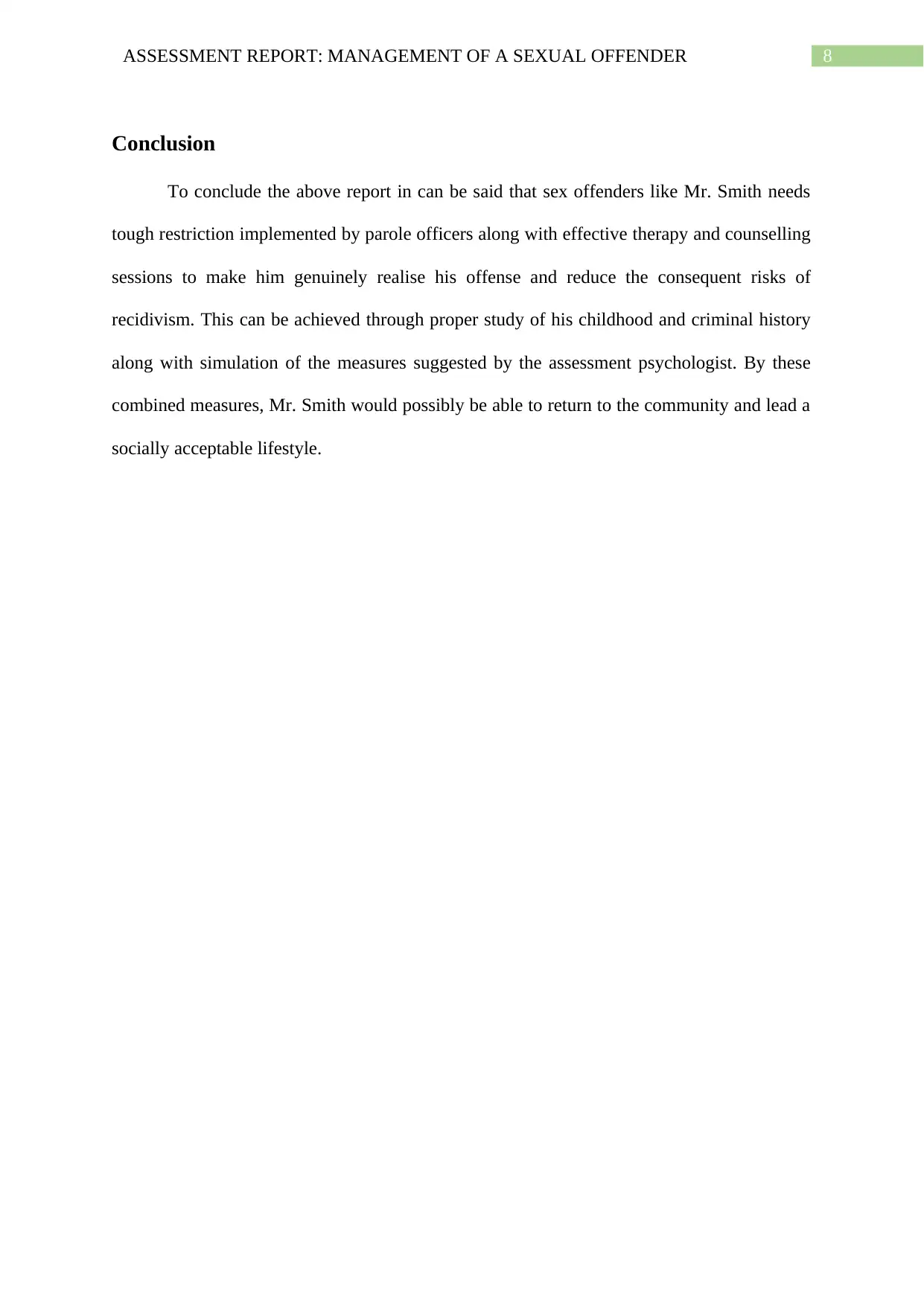
8ASSESSMENT REPORT: MANAGEMENT OF A SEXUAL OFFENDER
Conclusion
To conclude the above report in can be said that sex offenders like Mr. Smith needs
tough restriction implemented by parole officers along with effective therapy and counselling
sessions to make him genuinely realise his offense and reduce the consequent risks of
recidivism. This can be achieved through proper study of his childhood and criminal history
along with simulation of the measures suggested by the assessment psychologist. By these
combined measures, Mr. Smith would possibly be able to return to the community and lead a
socially acceptable lifestyle.
Conclusion
To conclude the above report in can be said that sex offenders like Mr. Smith needs
tough restriction implemented by parole officers along with effective therapy and counselling
sessions to make him genuinely realise his offense and reduce the consequent risks of
recidivism. This can be achieved through proper study of his childhood and criminal history
along with simulation of the measures suggested by the assessment psychologist. By these
combined measures, Mr. Smith would possibly be able to return to the community and lead a
socially acceptable lifestyle.
⊘ This is a preview!⊘
Do you want full access?
Subscribe today to unlock all pages.

Trusted by 1+ million students worldwide
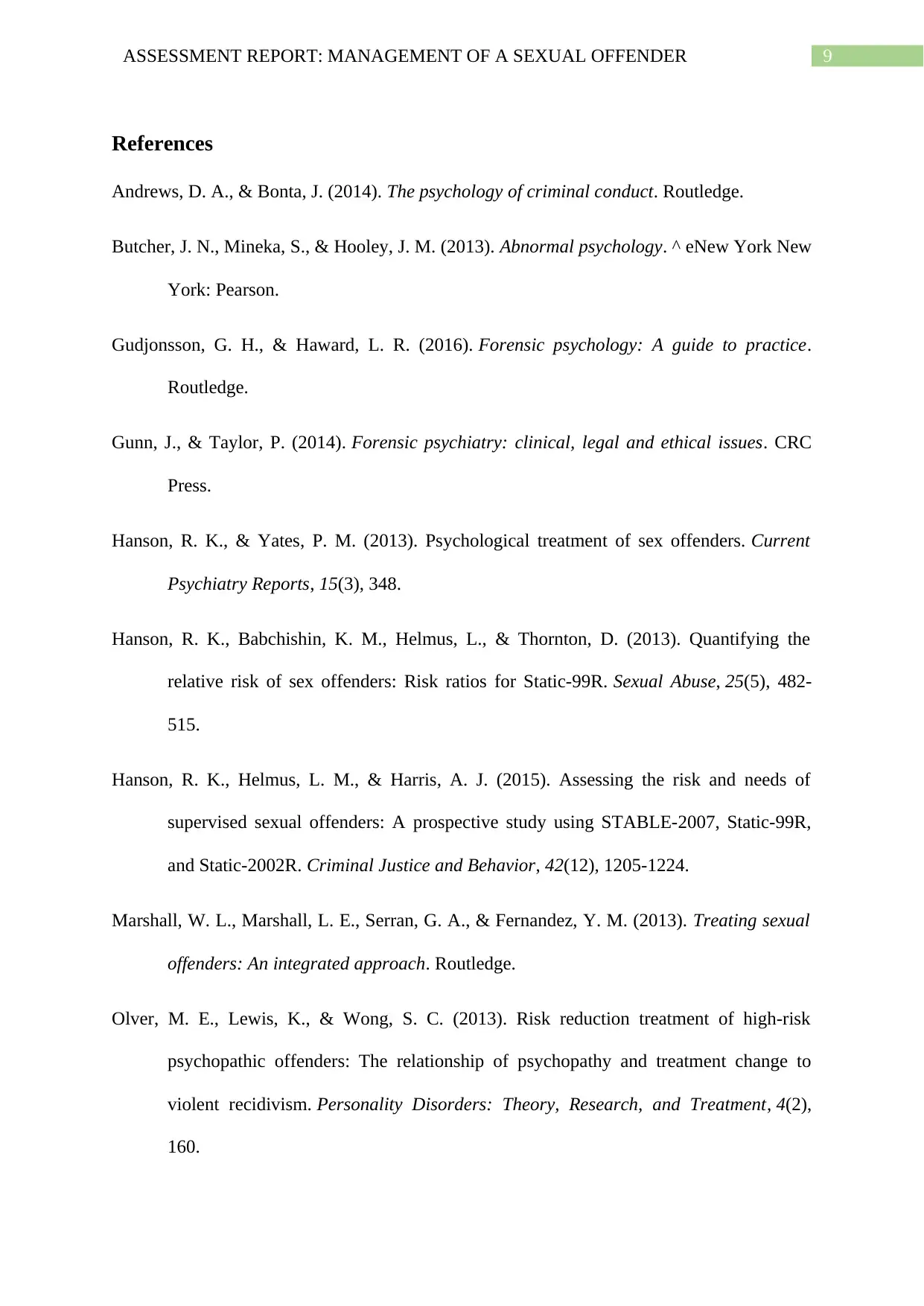
9ASSESSMENT REPORT: MANAGEMENT OF A SEXUAL OFFENDER
References
Andrews, D. A., & Bonta, J. (2014). The psychology of criminal conduct. Routledge.
Butcher, J. N., Mineka, S., & Hooley, J. M. (2013). Abnormal psychology. ^ eNew York New
York: Pearson.
Gudjonsson, G. H., & Haward, L. R. (2016). Forensic psychology: A guide to practice.
Routledge.
Gunn, J., & Taylor, P. (2014). Forensic psychiatry: clinical, legal and ethical issues. CRC
Press.
Hanson, R. K., & Yates, P. M. (2013). Psychological treatment of sex offenders. Current
Psychiatry Reports, 15(3), 348.
Hanson, R. K., Babchishin, K. M., Helmus, L., & Thornton, D. (2013). Quantifying the
relative risk of sex offenders: Risk ratios for Static-99R. Sexual Abuse, 25(5), 482-
515.
Hanson, R. K., Helmus, L. M., & Harris, A. J. (2015). Assessing the risk and needs of
supervised sexual offenders: A prospective study using STABLE-2007, Static-99R,
and Static-2002R. Criminal Justice and Behavior, 42(12), 1205-1224.
Marshall, W. L., Marshall, L. E., Serran, G. A., & Fernandez, Y. M. (2013). Treating sexual
offenders: An integrated approach. Routledge.
Olver, M. E., Lewis, K., & Wong, S. C. (2013). Risk reduction treatment of high-risk
psychopathic offenders: The relationship of psychopathy and treatment change to
violent recidivism. Personality Disorders: Theory, Research, and Treatment, 4(2),
160.
References
Andrews, D. A., & Bonta, J. (2014). The psychology of criminal conduct. Routledge.
Butcher, J. N., Mineka, S., & Hooley, J. M. (2013). Abnormal psychology. ^ eNew York New
York: Pearson.
Gudjonsson, G. H., & Haward, L. R. (2016). Forensic psychology: A guide to practice.
Routledge.
Gunn, J., & Taylor, P. (2014). Forensic psychiatry: clinical, legal and ethical issues. CRC
Press.
Hanson, R. K., & Yates, P. M. (2013). Psychological treatment of sex offenders. Current
Psychiatry Reports, 15(3), 348.
Hanson, R. K., Babchishin, K. M., Helmus, L., & Thornton, D. (2013). Quantifying the
relative risk of sex offenders: Risk ratios for Static-99R. Sexual Abuse, 25(5), 482-
515.
Hanson, R. K., Helmus, L. M., & Harris, A. J. (2015). Assessing the risk and needs of
supervised sexual offenders: A prospective study using STABLE-2007, Static-99R,
and Static-2002R. Criminal Justice and Behavior, 42(12), 1205-1224.
Marshall, W. L., Marshall, L. E., Serran, G. A., & Fernandez, Y. M. (2013). Treating sexual
offenders: An integrated approach. Routledge.
Olver, M. E., Lewis, K., & Wong, S. C. (2013). Risk reduction treatment of high-risk
psychopathic offenders: The relationship of psychopathy and treatment change to
violent recidivism. Personality Disorders: Theory, Research, and Treatment, 4(2),
160.
Paraphrase This Document
Need a fresh take? Get an instant paraphrase of this document with our AI Paraphraser
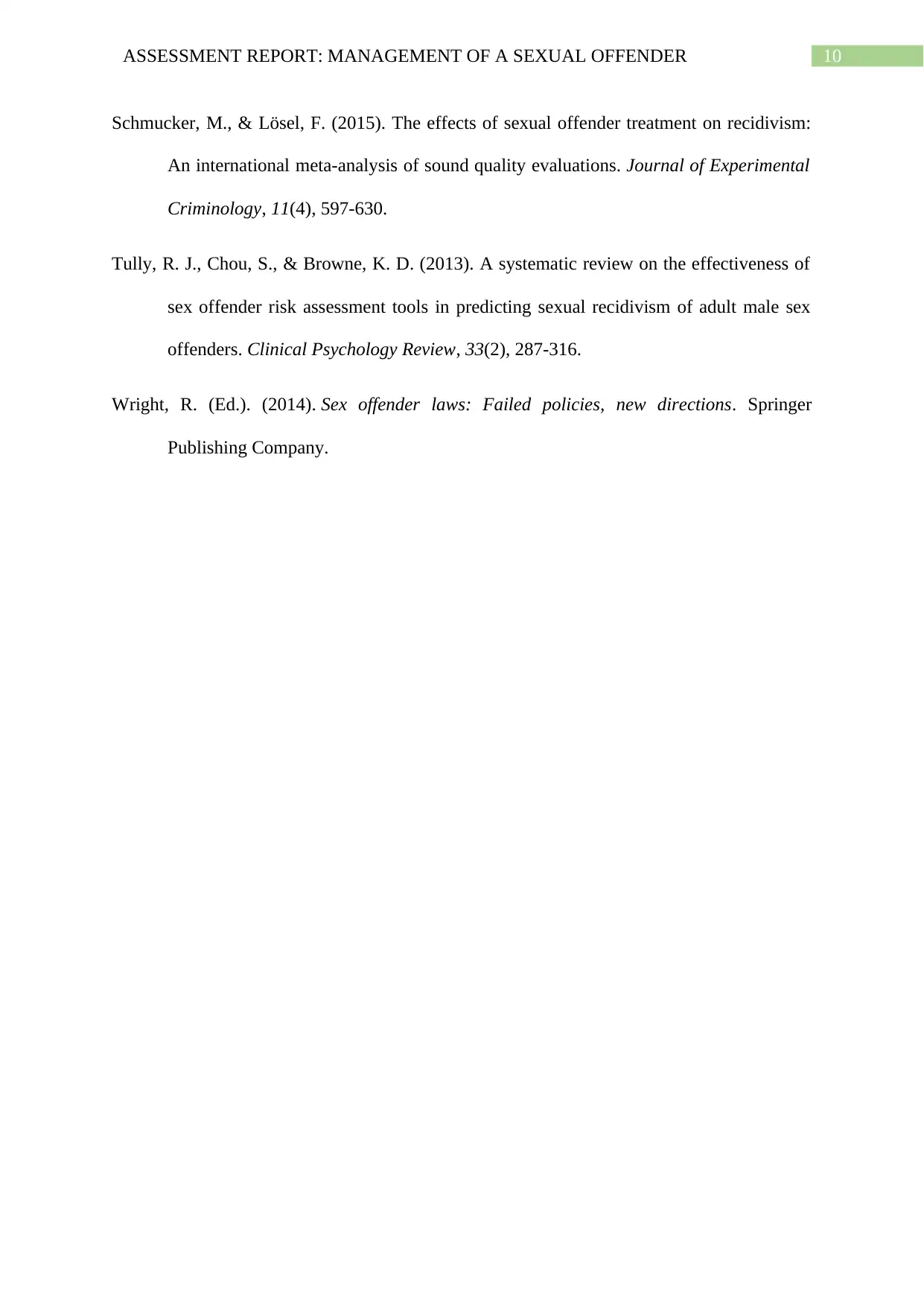
10ASSESSMENT REPORT: MANAGEMENT OF A SEXUAL OFFENDER
Schmucker, M., & Lösel, F. (2015). The effects of sexual offender treatment on recidivism:
An international meta-analysis of sound quality evaluations. Journal of Experimental
Criminology, 11(4), 597-630.
Tully, R. J., Chou, S., & Browne, K. D. (2013). A systematic review on the effectiveness of
sex offender risk assessment tools in predicting sexual recidivism of adult male sex
offenders. Clinical Psychology Review, 33(2), 287-316.
Wright, R. (Ed.). (2014). Sex offender laws: Failed policies, new directions. Springer
Publishing Company.
Schmucker, M., & Lösel, F. (2015). The effects of sexual offender treatment on recidivism:
An international meta-analysis of sound quality evaluations. Journal of Experimental
Criminology, 11(4), 597-630.
Tully, R. J., Chou, S., & Browne, K. D. (2013). A systematic review on the effectiveness of
sex offender risk assessment tools in predicting sexual recidivism of adult male sex
offenders. Clinical Psychology Review, 33(2), 287-316.
Wright, R. (Ed.). (2014). Sex offender laws: Failed policies, new directions. Springer
Publishing Company.
1 out of 11
Your All-in-One AI-Powered Toolkit for Academic Success.
+13062052269
info@desklib.com
Available 24*7 on WhatsApp / Email
![[object Object]](/_next/static/media/star-bottom.7253800d.svg)
Unlock your academic potential
Copyright © 2020–2025 A2Z Services. All Rights Reserved. Developed and managed by ZUCOL.

